Engage Your Community when Planning for Change
Find out strategies for assessing community needs, making plans and implementing new ideas in this webinar write-up.
Your role in your public library elevates you to a community leader and change agent. No matter your formal title or the size of your library, you have the opportunity to meet and evolve with your communities' changing needs. As a central learning and gathering space, your library supports the needs of a wide range of community needs for children, businesses, tribal communities, seniors, English language learners, the list goes on. With such a range of stakeholders in your community, how do you learn about your communities' evolving needs and then plan for change?
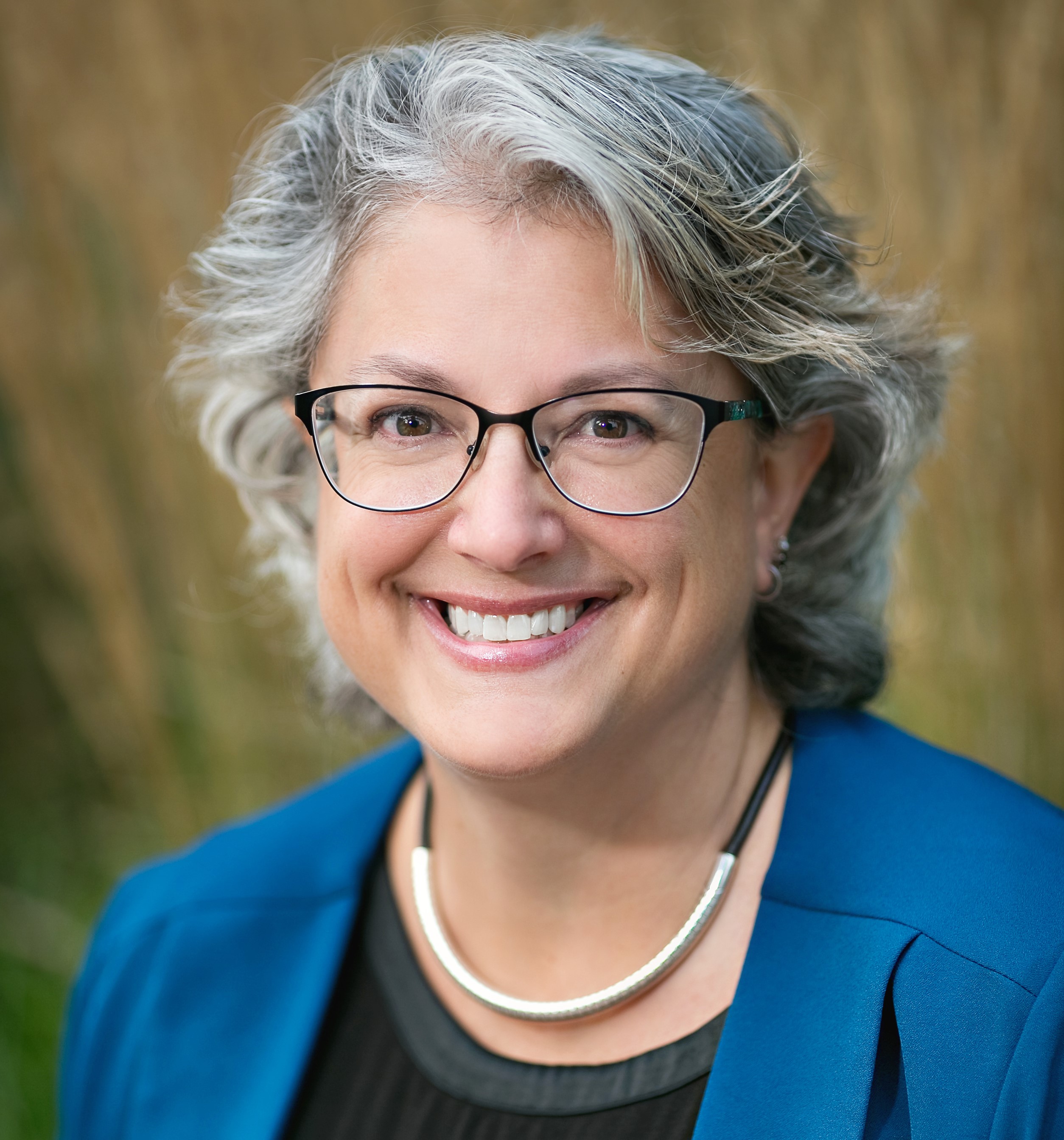 In the recent webinar Engaged Planning: Ask What You Can Do For Your Rural Community, Cindy Fesemyer, Director, Columbus (WI) Public Library, led us through her public library's process to assess community needs, make plans and implement new ideas. This is no small task. And, no greater opportunity. This process can feel daunting, so Fesemyer shared her journey and some practical ways to get started and make new connections.
In the recent webinar Engaged Planning: Ask What You Can Do For Your Rural Community, Cindy Fesemyer, Director, Columbus (WI) Public Library, led us through her public library's process to assess community needs, make plans and implement new ideas. This is no small task. And, no greater opportunity. This process can feel daunting, so Fesemyer shared her journey and some practical ways to get started and make new connections.
Much of Fesemyer's experience was influenced by ALA's Libraries Transforming Communities initiative, the Aspen Institute Dialog on Public libraries report: Rising to the Challenge: Re-Envisioning Public Libraries and the Harwood Institute—and rightly so! These reports and tools provide great resources to learn and to get started.
Getting Started: Turn Inward
A good place to start is to perform an internal assessment of your library and the services and assets you already provide. Fesemyer asks us to consider what your library is bringing to the table before you begin your planning. It's good to know what you're starting with! Consider assets such as your library staff, your range of collections and offerings, the technology services you make available, maker-spaces you lead, early literacy efforts, etc. Then consider the communities you currently serve at your library.
Who are you reaching today on a regular basis? Who are you reaching only occasionally? Are there other communities that you have not identified or reached out to in the past as a part of your planning and assessment efforts? Why do you think you haven't considered them as core communities in the past? Why are they important now?
Community Surveys
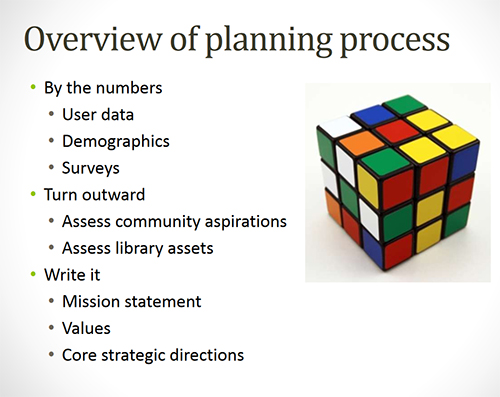 Once you have a few lists of who you reach and how you reach individuals today, you can draft a survey to learn more about your community. Fesemyer shared some great observations around asking the best range of questions and finding the right mix of survey formats. What do returning patrons use the library for today? What do they wish they could do at the library that they don't see or experience today? What about a new library card holder? What brought them to the library now and what will keep them coming back?
Once you have a few lists of who you reach and how you reach individuals today, you can draft a survey to learn more about your community. Fesemyer shared some great observations around asking the best range of questions and finding the right mix of survey formats. What do returning patrons use the library for today? What do they wish they could do at the library that they don't see or experience today? What about a new library card holder? What brought them to the library now and what will keep them coming back?
Mix up the format. Nearly half of Fesemyer's community responses came from paper format surveys. For your regular patrons, keep the paper survey at the desk and ask if they'd be willing to fill it out. For those patrons who frequent your library's website, add a link or a pop-up survey from your home page to entice your online community to share their feedback. You're likely to learn a range of information and perspectives.
Diversify your survey channel. Beyond the front desk and online, what about community members who don't use the library? What do they need? This can be an opportunity to learn and share. One example is to partner with your town or regional services. What bills or flyers are already being sent out to the community at large? Fesemyer shared a wonderful example of including a bill insert with Columbus Water and Light, which broadened their reach.
Learn about the surveys that are already being conducted in your area and ask if your library can include a question or two as a part of the larger effort. This is a great way to seek input and remind other local government agencies about the work you do.
Next, draft your survey. This step often feels daunting. There's an art to creating surveys and asking the right questions. Luckily, Fesemyer and our webinar learners pointed us to a number of resources that you can find in the sidebar at right.
Getting help can be a wise investment. As a powerful example of when seeking help from an expert can really pay off, Fesemyer shared the value and impact that engaging an outside consultant made in their overall effort. With an investment of $5,000, she worked with an outside consultant who was able to set a reasonable timeline, suggest the tools to use, interpret data, map users, keep the project on track and report results the library board.
Turn Outward: Community-based Planning
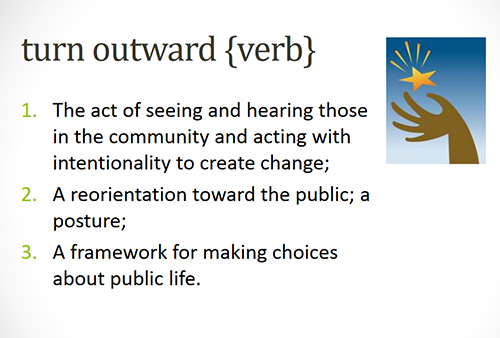 You can't really know what your community needs unless you ask people. To serve the community you need to be a part of the community. There is incredible value in going beyond your library walls, online surveys and mailings: there's really nothing better than talking to people in your community. Even if it feels scary! And, if you don't know different communities within your town, reach out to people who do and ask for their help.
You can't really know what your community needs unless you ask people. To serve the community you need to be a part of the community. There is incredible value in going beyond your library walls, online surveys and mailings: there's really nothing better than talking to people in your community. Even if it feels scary! And, if you don't know different communities within your town, reach out to people who do and ask for their help.
Based on ALA's Libraries Transforming Communities, Fesemyer referenced A Step-by-Step Guide to "Turning Outward" to Your Community (PDF). This is a helpful tool to guide you through the phases of affecting change in your community. Can you stand on the table and tell people in your community what they want? With authority? With authenticity? With accountability? These are the "3 A's of Public Life," a section within the Turning Outward guide that can help you gain confidence in telling people in your community what the library has heard and what the community wants.
This can be a hard proposition. Many webinar participants shared that asking for community input was new territory and made them nervous, scared and even terrified. Those feelings are likely telling us that this is the work we need to do. Get out of our comfort zone, begin asking and listening.
The Turning Outward guide also outlines questions through the ASK Exercise to aid you in reaching out and verbally asking questions of your community. Learn more about this exercise by watching the webinar recording and downloading the guide.
Community Conversations
Fesemyer also shared examples of a more formal and facilitated process, based on the Turning Outward guide, called Community Conversations, in which groups of 15 to 20 community members are invited to share and discuss what the people in the room want in the community. This type of conversation should range from 90 minutes to two hours, and begins with the key question: What kind of community do you want? Once you've heard from everyone in a group, themes will begin to emerge and the facilitator can work with the group to begin to narrow down the focus of this group's conversation. With one or two key topics identified, the group will dive more deeply into the rest of the questions. The goal is not to ask about the library or a library product or service but to keep it community centered, learning about what the community needs.
You'll hear a range of responses, depending greatly on the group you've connected with. If you're facilitating a conversation with your town's chamber of commerce, you may hear the request for more city support in marketing their businesses, or if you're meeting with middle schoolers, you may hear an excited request for a water slide at school!
Through that initial question, you will likely begin to see themes emerge that can lead you to new and creative ideas and sound decisions. The guide itself provides great instructions around planning the conversation, setting expectations and where to hold conversations. The webinar recording and the guide provide examples of facilitated questions you can use in your conversations.
A great piece of advice from Fesemyer: start with a group that you may already have a relationship with, such as your local rotary club or the local business association, and get comfortable with the Community Conversations process. Then reach out to new partners or unfamiliar community groups once you know the process a little better. You'll find more success by partnering with groups than sending out an open invitation to participate in these conversations, remembering to keep those partnerships broad in scope so that you're reaching a diverse perspective, always asking "who is not at the table?"
Hearing from Your Community in Creative Ways
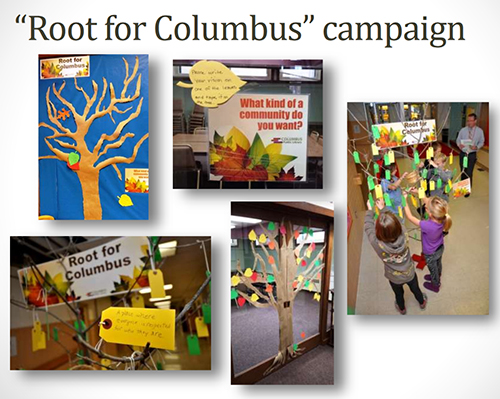 As one way of reaching out and hearing from a wide-range of people in their community, Fesemyer shared the story of their creative "Root for Columbus" campaign. Upon receiving advice that these engagement efforts should be visible in the community, they came up with the idea of creating their own version of a wish tree. Traveling throughout the community, they started with a large bare tree branch in a visible space, at local elementary schools, a gas station, bank lobby, coffee shop, local hospital, etc., and offered colorful paper leaves to allow anyone who encountered this tree to write a response to the brief question: "What kind of community do you want?"
As one way of reaching out and hearing from a wide-range of people in their community, Fesemyer shared the story of their creative "Root for Columbus" campaign. Upon receiving advice that these engagement efforts should be visible in the community, they came up with the idea of creating their own version of a wish tree. Traveling throughout the community, they started with a large bare tree branch in a visible space, at local elementary schools, a gas station, bank lobby, coffee shop, local hospital, etc., and offered colorful paper leaves to allow anyone who encountered this tree to write a response to the brief question: "What kind of community do you want?"
Through this effort, they received 400 to 500 leaves with responses answering this participatory question. As leaves began to spout onto this traveling tree, they started getting press, spreading the word about this important question and fun way for the community to engage. They also began to see some statistical information—the number of leaves made it easy to identify themes and quantify the number of responses of what people thought in response to this question! Another way to learn from people outside of the library.
Reporting Back
After collecting information from the community through these many forms of engagement, a crucial step is to report back—to your library board, to local stakeholders and the community. This is also a great way to engage your trustees to leverage their connections and share back to the community.
Through their community engagement efforts, Columbus (WI) Public Library, reported that people wanted a sense of community and to heal the loggerheads of small-town tradition vs. college-town innovation clashes that have developed over time. The community also wanted more after-school activities for school-age kiddos and teens, and many adults wanted opportunities for social interaction and a centralized calendar of events for all the things that are going on around town. These were all topics that the library could begin to plan toward and address.
Some of the things that came out from the many forums and conversations were beyond the library role: fix the potholes in the road, no high taxes, etc., and because the library asked the questions, and because people want to feel heard, the library included these topics in their reports as well, with the promise that they'll pass on that information to other powers that be.
How Ready for Change is Your Community?
Now that you know what the community wants, how do you know where to begin? How much change can your community bear? There are quick things you can change, like adding weekly after-school Lego groups to your programming or a community events calendar, but what about the bigger transformations or culture shifts that require broad partnerships throughout the community?
Libraries Transforming Communities created a handout to help you identify the readiness of your community to change: Calibrating Community Conditions / Moving from Aspirations to Action: Step 1. This guide is a helpful tool you can use to identify the rhythms of your community and how big or how small you need to begin in your coordinated community responses. For Fesemyer's library, which landed somewhere between Impasse and Catalytic, they realized they just couldn’t do a large community coordinated effort—there just wasn't the buy-in—but they could try something small: they started having potlucks to gather people to feed each other, discuss and brainstorm ideas to work on in the coming months.
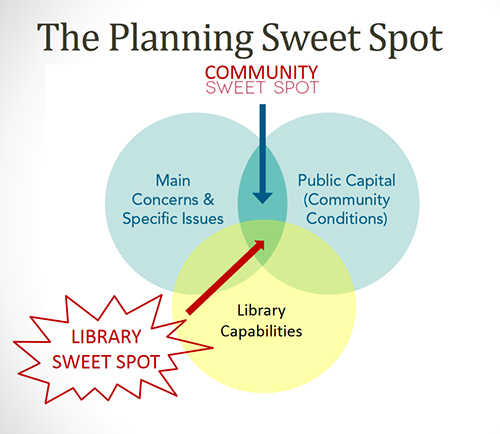 Through all of these community conversations and the resulting themes and topics, you'll look to identify the "sweet spot of public life" or the main concerns or themes that surface and what the community is ready to move forward on. If there is some level of consensus and willingness to identify and implement new ideas, you're in a good space to move forward to define clear plans for change. If there is no consensus around community need identified, it is an opportunity to continue to explore community aspirations and keep talking. This is also a great opportunity to identify your library's assets as they pertain to the needs identified.
Through all of these community conversations and the resulting themes and topics, you'll look to identify the "sweet spot of public life" or the main concerns or themes that surface and what the community is ready to move forward on. If there is some level of consensus and willingness to identify and implement new ideas, you're in a good space to move forward to define clear plans for change. If there is no consensus around community need identified, it is an opportunity to continue to explore community aspirations and keep talking. This is also a great opportunity to identify your library's assets as they pertain to the needs identified.
Blending these three areas, what your community wants to work on, what amount of change they can bear, and what the library can offer in support of these changes is the "library planning sweet spot."
Watch the full webinar recording for free at any time to learn more from Fesemyer.
Watch the webinar Engaged Planning: Ask What You Can Do For Your Rural Community for free at your convenience.
Access Recording
- View Webinar Recording (You will be prompted to log in to our free Course Catalog.)
Webinar Attachments
- View slides (pdf)
- View chat (xls)
- View captions (txt)
- Learner Guide (doc) Use alone or with others to extend your learning.
